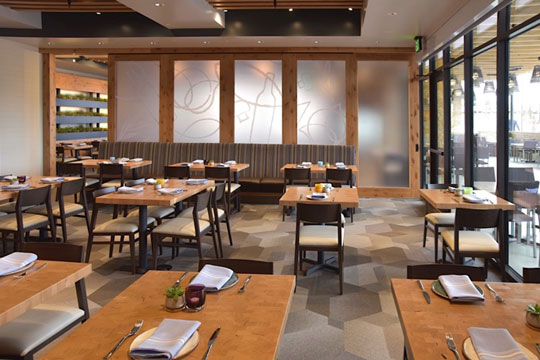Savor Authentic Eastern Food With a Pan-Asian Twist for a Culinary Journey
Getting started on a culinary journey with authentic Eastern food, improved with a Pan-Asian twist, supplies a special possibility to discover the rich tapestry of tastes that specify the area's diverse cooking practices. This experience invites you to enjoy the elegant balance of preferences-- wonderful, salty, spicy, and sour-- balanced by fragrant herbs and seasonings. Envision the ingenious combination of Thai curry and ramen or the unexpected pleasure of sushi burritos. As you ponder these enticing recipes, take into consideration the cultural stories and historical impacts that form them, each bite offering a story waiting to be found.

Exploring Pan-Asian Tastes
In the world of global gastronomy, Pan-Asian cuisine attracts attention for its amazing diversity and the unified interaction of flavors from various Asian societies. This culinary strategy commemorates the abundant customs and distinct active ingredients found throughout the continent, producing a tapestry of tastes that is both gratifying and appealing. Key to Pan-Asian cuisine is its capacity to stabilize different tastes-- sweet, salty, spicy, and sour-- while highlighting the quality and quality of each component.
From the umami-rich soy sauce of Japan to the intense chili peppers of Thailand, Pan-Asian cuisine provides a comprehensive scheme of flavors. These elements are commonly incorporated in inventive means, improving dishes with layers of intricacy. As an example, making use of fragrant herbs such as lemongrass and cilantro, common in Vietnamese and Thai cuisine, adds a rejuvenating brightness to meals, while the incorporation of coconut milk provides a luscious, rich structure.
The emphasis on fresh fruit and vegetables and aromatic seasonings makes sure that each dish is not only a banquet for the palate but also for the senses. Pan-Asian cuisine welcomes restaurants to start a cooking trip, discovering the vast and varied landscapes of Oriental gastronomy with every bite.
Combination Dishes to Attempt
While Pan-Asian food is celebrated for its traditional flavors, the contemporary culinary landscape is progressively welcoming blend recipes that mix these traditional elements with impacts from other areas. This innovative strategy not just honors the abundant heritage of Eastern cookeries but also introduces novel taste experiences that interest modern tastes.
A prime instance of such a blend meal is the Korean-Mexican taco, where marinated bulgogi beef is wrapped in a cozy tortilla, covered with kimchi and a spicy gochujang-infused salsa. This mix weds the bold, mouthwatering tastes of Korea with the lively, fresh components of Mexican cuisine. Similarly, sushi burritos have gotten popularity, amalgamating the delicate artistry of Japanese sushi with the hearty, hand-held convenience of a burrito, typically including blend components like tempura shrimp and avocado with a drizzle of wasabi mayo.
An additional notable meal is Thai curry ramen, which instills the luscious, aromatic flavors of Thai curry right into the reassuring brew of standard Japanese ramen, developing an unified blend that tantalizes the detects. These fusion meals expand past simple uniqueness; they stand for a culinary discussion in between cultures, motivating exploration and innovation in the globe of Pan-Asian cuisine.
Vital Active Ingredients and Seasonings
To absolutely value Pan-Asian cuisine, one have to recognize the necessary active ingredients and flavors that form its foundation. This diverse cooking style attracts from a rich tapestry of Eastern practices, utilizing a harmonious mix of flavors and appearances. Secret active ingredients include soy sauce, fish sauce, and oyster sauce, which pass on a full-flavored umami depth vital to Eastern meals. Corresponding to these are rice vinegar and mirin, offering a fragile acidity and sweet taste.
Fragrant elements are pivotal, with lemongrass, garlic, and ginger being ubiquitous across various Pan-Asian dishes. These ingredients offer an aromatic base that improves the complexity of tastes. Flavors such as star anise, cardamom, and cinnamon introduce heat and personality, echoing influences from areas like China and India.

Cooking Strategies and Tips
Grasping the art of Pan-Asian cuisine calls for experience with its distinctive cooking strategies, each adding to the vibrant tapestry of tastes this cooking custom is celebrated for. Central to these methods is the stir-fry, a quick food preparation method that preserves the dietary stability and vibrant colors of active ingredients. Utilizing a frying pan, the stir-fry method permits for also warm circulation, essential navigate to this website for attaining the characteristic texture and flavor balance of Pan-Asian dishes.
Another essential technique is steaming, specifically common in Chinese cuisine. This gentle technique maintains the all-natural tastes and nutrients of active ingredients, making it excellent for fish and shellfish and veggies. Dumplings, a precious staple, usually gain from steaming, leading to soft, succulent appearances.
Grilling, also important, gives great smoky midsts to meals such as Oriental bulgogi or Japanese yakitori (asian restaurant isb). This technique typically includes seasoning ingredients, permitting flavors to permeate deeply before cooking over an open flame or warmer
Finally, understanding the art of balancing tastes-- pleasant, sour, salty, bitter, and umami-- is crucial. Correctly layering these elements can raise a dish from average to phenomenal, supplying a complicated and pleasing cooking experience that embodies the significance of Pan-Asian cuisine.
Eating Experiences Worldwide
Throughout the world, Pan-Asian cuisine offers an unparalleled eating experience, celebrated for its abundant tapestry of flavors and vivid discussions. This culinary phenomenon has actually transcended social limits, recording the hearts and palates of food lovers worldwide. In cosmopolitan cities fresh York, London, and Sydney, Pan-Asian dining establishments offer as fusions where culinary practices from navigate here Thailand, Japan, China, and past converge, offering diners with a diverse mix of meals that highlight the region's diversity.
The global appeal of Pan-Asian food exists in its capability to offer both authenticity and innovation. Chefs skillfully wed standard components such as lemongrass, soy sauce, and miso with contemporary strategies, leading to dishes that are both familiar and refreshingly new. This fusion permits restaurants to embark on a cooking trip that respects heritage while accepting modernity.
Moreover, dining experiences are raised via attentively designed settings that reflect the principles of Pan-Asian aesthetic appeals. From minimal Japanese-inspired insides to lively Thai-themed rooms, each restaurant supplies an unique setting that matches the culinary offerings. As an outcome, patrons are not just taking in a dish but partaking in a cultural experience, making Pan-Asian dining a really worldwide sensation.
Final Thought
The exploration of Pan-Asian food provides an extensive understanding of the elaborate interaction of flavors and cooking traditions across Asia. By welcoming blend dishes such as Thai curry ramen and sushi burritos, the culinary trip not just highlights the versatility of typical ingredients however additionally showcases ingenious modern techniques. This gastronomic journey, enriched by cooking techniques and important flavors, provides a special opportunity to appreciate the cultural diversity and cooking virtuosity that specify Pan-Asian cuisine on a global scale.
Embarking on a cooking journey through authentic official source Oriental food, enhanced with a Pan-Asian spin, offers an unique possibility to explore the rich tapestry of tastes that define the region's varied cooking customs.In the world of global gastronomy, Pan-Asian cuisine stands out for its amazing diversity and the unified interaction of tastes from different Eastern cultures. Key to Pan-Asian cuisine is its ability to balance different flavors-- wonderful, salted, spicy, and sour-- while highlighting the freshness and high quality of each active ingredient.
